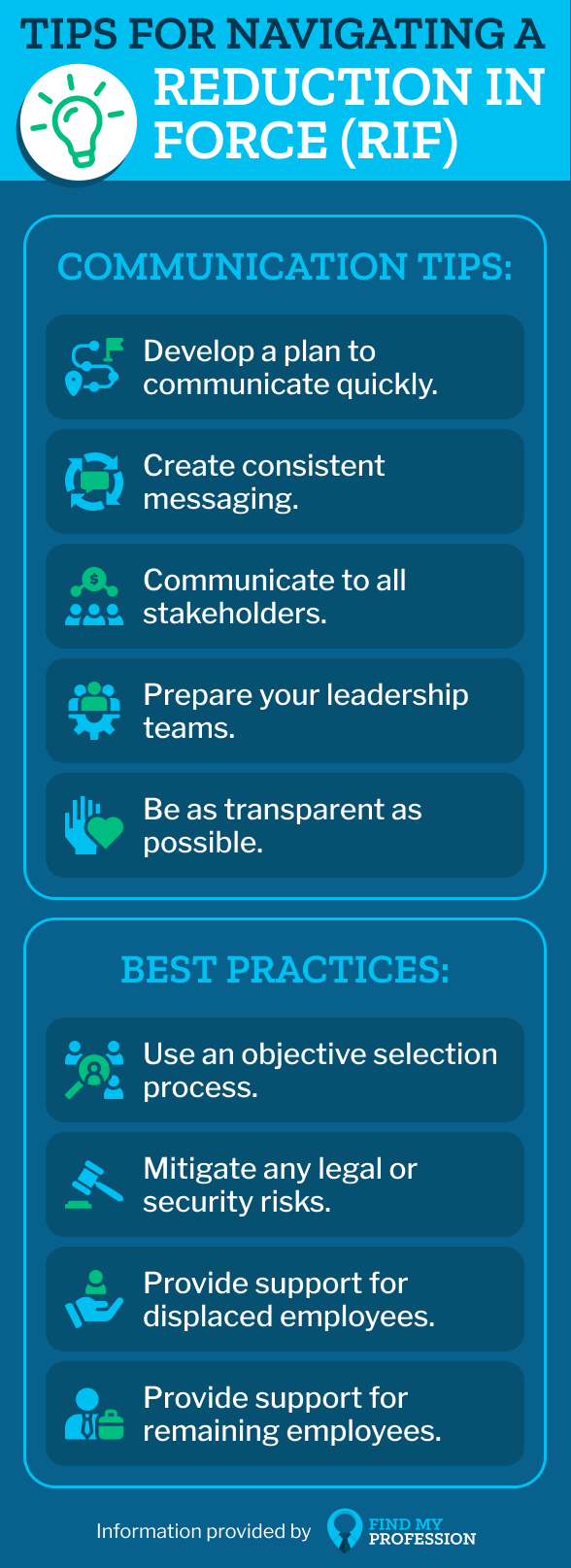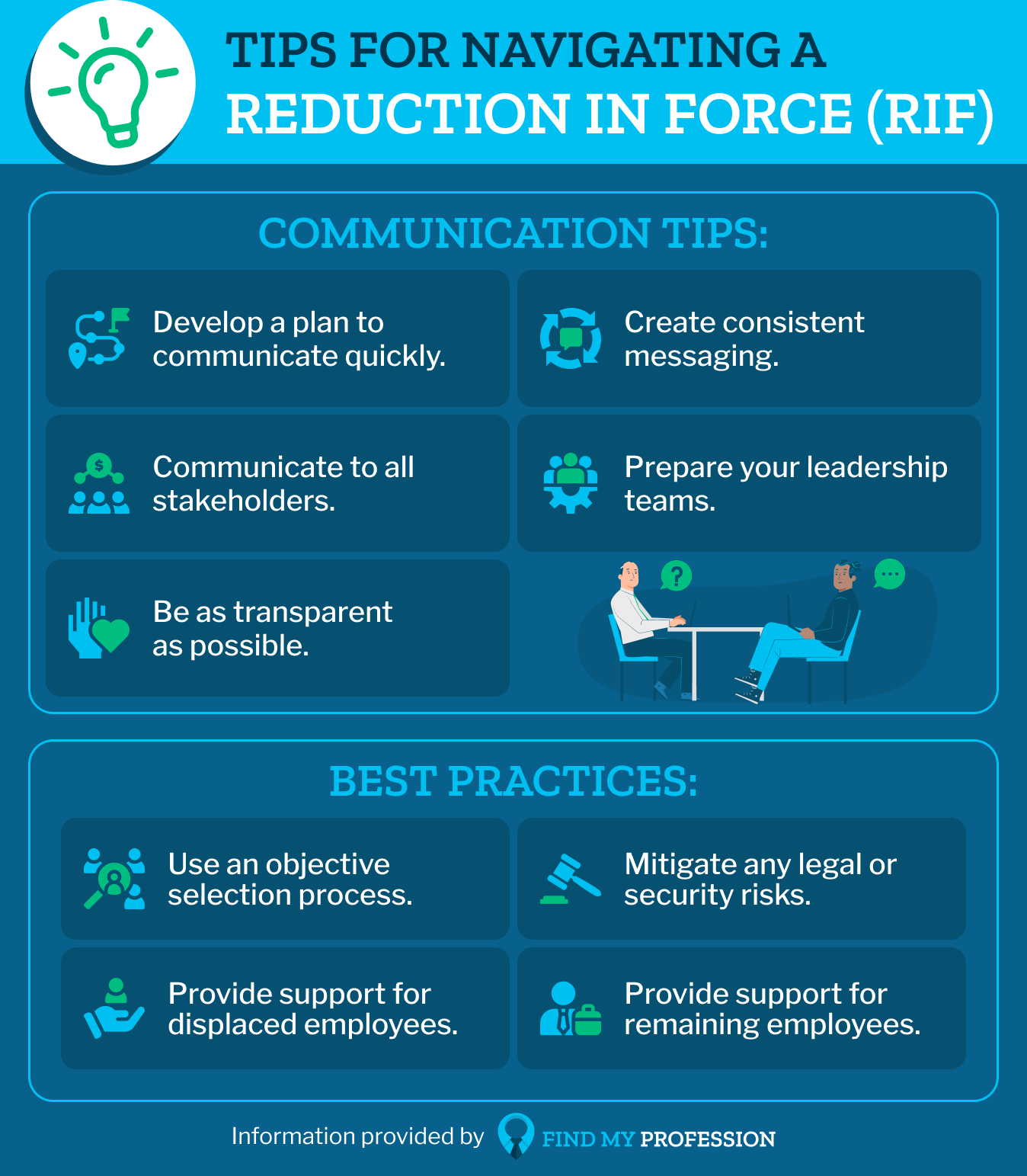“We’re undergoing a reduction in force.” Those are the words no employee wants to hear, and no employer wants to utter. Unfortunately, reductions in force (RIFs) are common, especially in times of economic turbulence.
Planning and executing a RIF is by no means simple. Determining which roles to cut can be a challenge, and the resulting fallout can be demoralizing to your people, and catastrophic for your company culture.
Thankfully, there are ways to make the process smoother for everyone involved. In this piece, we’ll explore the negative impacts of a RIF and share best practices you can follow to ensure those affected are well taken care of after the dust settles.


What Is a Reduction in Force (RIF)?
A reduction in force (RIF) is the act of permanently eliminating roles within an organization. Also known as downsizing, a RIF is often implemented by leadership or HR teams as a cost-cutting measure to combat financial hardships, meet the needs of investors, or generate a positive cash flow.
While a RIF can be daunting, there are best practices to follow, to navigate the process through to a successful conclusion.
What’s the Difference Between a Furlough, a Layoff, and a RIF?
During a furlough, employees undergo either an unpaid leave of absence or a reduction in working hours — both typically temporary. During a layoff, employees actually lose their jobs, but may be rehired in the future. A RIF, however, is permanent — jobs are cut and likely won’t be filled again.

Looking for Outplacement Services?
Find My Profession offers job search support for your displaced employees with resume writing and reverse recruiting services.
What Causes a Reduction in Force?
A reduction in workforce typically occurs when a company must drastically reduce its payroll costs. An economic downturn or recession is the most likely driver (as seen during the height of the pandemic). However, a RIF can also be issued as part of a broader strategic pivot or reorganization.
How Can My Company Avoid a RIF?
An employment RIF can often be avoided with the right hiring strategy. Whenever a company scales its hiring efforts dramatically in a short timeframe, there’s always some risk they won’t be able to maintain the workforce at the new level.
Consult with senior leaders about how much risk you’re comfortable taking on, and only hire for roles that will drive revenue.
If you’re already facing a RIF and you’d like to avoid it, consider some of the RIF alternatives below.
Alternatives to a Reduction in Force
There are other ways to trim payroll costs than conducting a job RIF or layoff.
- Hiring freeze: You can issue a hiring freeze and let natural attrition gradually reduce your headcount.
- Pay cut: A company can initiate a furlough or company-wide pay cut, with the promise of rectifying pay once the company’s financials stabilize. With a pay cut, some employees may choose to exit the company, so nobody is forced to leave a job they love.
How Should My Organization Communicate a Reduction in Force?
A RIF notice shouldn’t be taken lightly. Announcing a workforce reduction will likely create a period of intense anxiety among employees. Ease that anxiety by being transparent. Explain why you’re doing a RIF, which positions are being impacted, and what to expect in the coming hours and days.
To communicate a RIF:
- Develop a plan to communicate the RIF right away.
- Create consistent messaging.
- Communicate to all stakeholders.
- Prep your senior leadership and management team.
- Be as open about the RIF as possible.
What Are the Impacts of a RIF?
Contemplating a reduction in force? Take heed. Here are the biggest downstream effects if you’re planning to let employees go:
1. Damaged Employer Brand
When a reduction in force hits — due to market turbulence or poor leadership foresight — companies often must let people go through no fault of their own. For those affected, this can spark frustration or outright resentment toward their former employer. And when people are unhappy, they tend to share those feelings with the world.
 Top Tip
Top Tip
Don’t let a reduction in force damage your company’s brand. Partner with Find My Profession, and give those impacted by a RIF a positive exit experience. Our outplacement experts will help them find work quickly and surely.
2. Lack of Trust in Leadership
Employees who make it through a RIF with their jobs intact often feel “survivor’s guilt.” They wonder why they weren’t let go with their peers, which can create moral anguish. They may also feel anxiety about the future, or anger toward the company and its leaders for causing this stress.
Fail to communicate a RIF properly, and you risk undermining the trust of your entire workforce. Even when the dust settles, you may struggle to move forward with your strategy, as employees second guess their decisions — and those of your leaders — in fear of another RIF.
This is why it’s so important to follow the steps above to communicate the reasons and the plan for your RIF effectively. Consistent messaging, clear and open communication, and even helping your employees find new jobs are the best ways to preserve your employer brand.
3. Disengagement and Attrition
A reduction in workforce can easily snowball. When employees distrust or lack faith in their leaders, they tend to lose interest in the company as a whole. Let that disengagement fester, and it can spark an oil fire of attrition.
Suddenly, the talent you worked so hard to cultivate starts to evaporate. A workforce reduction of 20% could balloon to 30% (or more) if frustrated employees quit.
Help former employees find new employment, however, and the news will trickle back into your remaining workforce. This will reassure your workforce and help to restore faith in the organization.
Best Practices When Navigating a RIF
The smoother your RIF process, the easier it is for everyone involved to heal and move forward. Here are four best practices when conducting a job RIF or layoff.
1. Have an Objective Selection Process
A surefire way to torpedo your brand is to terminate employees without a proper explanation. Research shows that the number-one driver of perceived fairness during a RIF is the logic behind who stays and who goes.
Whether your RIF layoffs are performance-based or out of people’s hands, be decisive about the roles you’re cutting, and why. Perform a cost-benefit analysis for each department at your organization, and use the results to decide which roles are most critical to cut (or save).
Don’t let personal feelings drive this process. Per HBR, RIFs and layoffs often result in biased retention decisions, which can result in a disproportionate amount of minorities (e.g., women, people of color) being let go. The more objective your selection process, the easier it is to avoid adverse impacts.
2. Mitigate Any Legal or Security Risks
Adverse impact isn’t the only potential risk during a RIF. If displaced employees feel burned, they could sue the company, steal or leak confidential information, or cause havoc over social media.
Always consult with your legal and IT teams prior to a RIF. Review and abide by the U.S. Department of Labor’s Worker Adjustment and Retraining Notification (WARN) Act, which stipulates that companies with 100 or more employees provide a 60-day RIF notice. Likewise, adhere to common IT best practices to ensure sensitive information stays that way.
3. Provide Support for Displaced Employees
You can largely avoid the doomsday scenarios above by investing in displaced employees during and after the RIF. Work with your finance team to provide generous reduction in force severance pay (e.g., one month’s salary per year of tenure). Likewise, give your employees a better healthcare option than COBRA, so they feel properly supported in their job search.
 Top Tip
Top Tip
Want to truly show your people you care? Use outplacement services like Find My Profession to give displaced employees an invaluable safety net. Our expert resume writers and recruiters will help them find a job they love.
4. Don’t Neglect the People Who Remain
It’s easy to consider a RIF “over” once the last person is let go. But the reality is, the hard work is just beginning. Your company culture won’t recover overnight from the reorganization, and you’ll need to earn back the trust of the employees who remain.
Hold an all-hands meeting to discuss what just happened, and ensure your people that their jobs are secure. Keep morale top of mind — according to Gallup, only 32% of employees are currently engaged, and 18% are actively disengaged. Instead of pointing blame, lead with empathy, and frame the RIF as an opportunity to grow closer and stronger as a workforce.
Key Takeaways
There’s never a great time to undergo a reduction in force. Cutting headcount will always cause anxiety and stress, but you can mitigate the risks with the right RIF process. Support displaced employees with outplacement services from Find My Profession, and make the most of a challenging situation.




